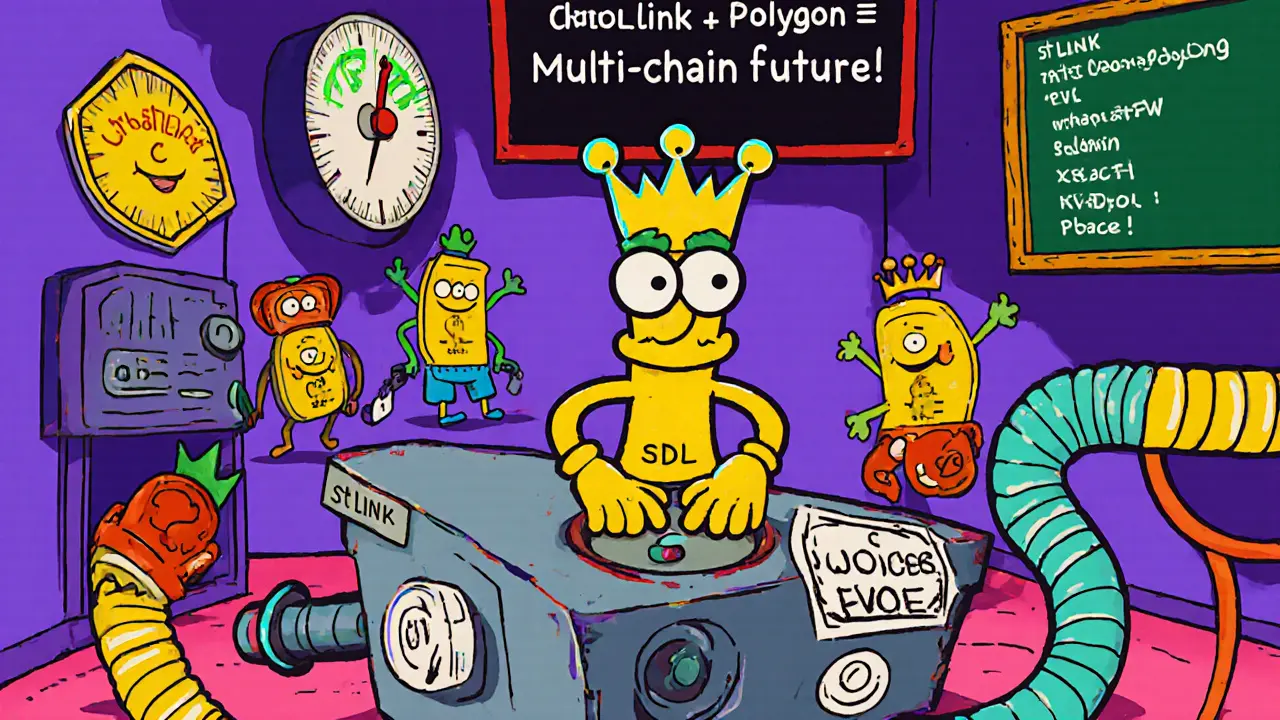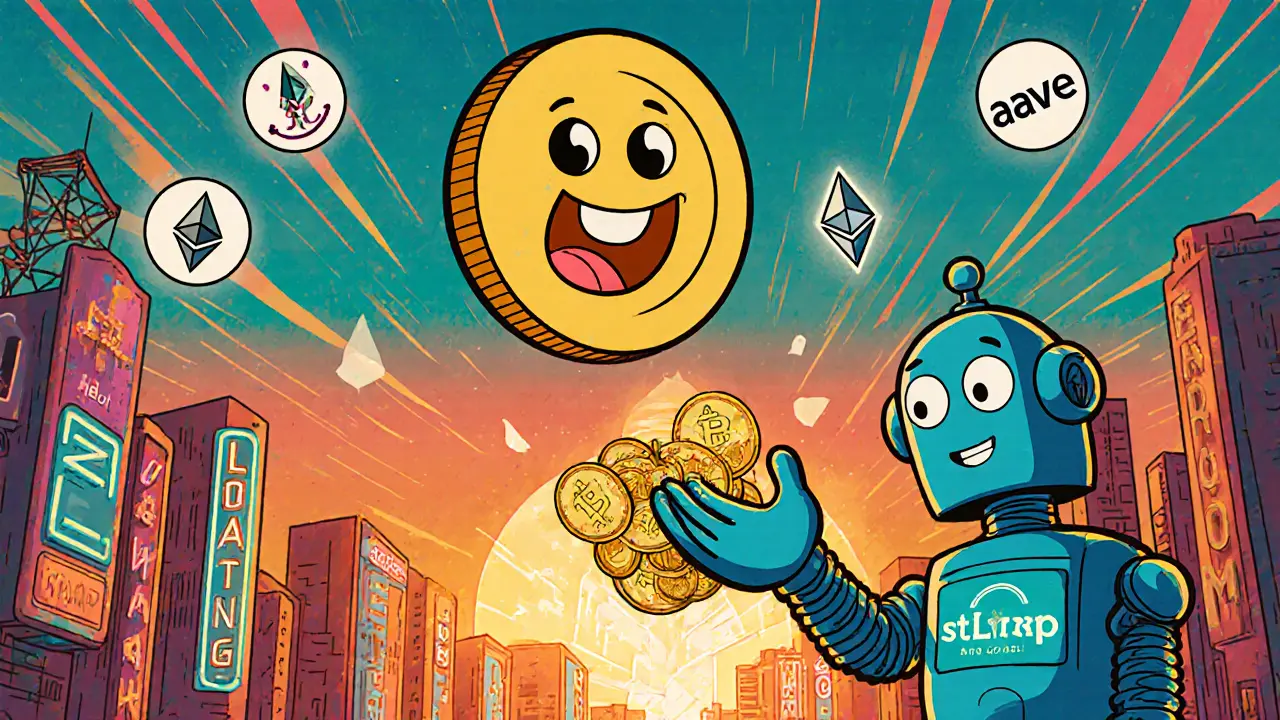Stake.link Staking Calculator
Estimate Your Staking Rewards
Calculate how much you could earn by staking your LINK tokens with stake.link. Based on current network data (as of October 2025).
Estimated Rewards
Enter your LINK amount and select a duration to see your estimated earnings.
Current APY: 5.15% (Average across all pools)
LINK Staking APY: 5.3%
POL Staking APY: 4.9%
Note: APYs may fluctuate based on network demand and token prices. Staking involves risk - only invest what you're willing to lose.
Most people know Chainlink (LINK) as the oracle network that connects blockchains to real-world data. But what if you could earn staking rewards from your LINK tokens - without locking them up? That’s where stake.link comes in. It’s not just another DeFi protocol. It’s the only liquid staking solution built specifically for Chainlink, and it uses its own token, SDL, to make it all work.
What exactly is stake.link?
stake.link is a decentralized platform that lets you stake your LINK tokens and get back a liquid version called stLINK. Think of stLINK like a receipt that proves you’ve staked LINK, but unlike locked-up staking, you can trade, lend, or use stLINK in other DeFi apps like Uniswap, Aave, or Curve. Your rewards keep compounding automatically - no need to log in every week to claim them. It launched in 2023 as the first project to solve a real problem: LINK can’t be staked directly on Ethereum. Chainlink’s staking happens on its own network, so holding LINK meant you couldn’t earn passive income without giving up liquidity. stake.link changed that by acting as a middleman. It pools LINK from users and stakes it on Chainlink’s network, then issues stLINK tokens in return. By October 2025, stake.link had $64.91 million locked in (TVL), all on Ethereum. That might sound small compared to Lido’s $29 billion, but it’s the only game in town for Chainlink stakers.What is the SDL token?
SDL is the native token of stake.link. It’s not a staking reward token like stLINK - it’s a governance and utility token. Holding SDL gives you a share of the platform’s fees. Every time someone stakes LINK or POL, a small fee goes into the system. A portion of those fees is distributed to SDL stakers. You can also use SDL to vote on upgrades, new chains to support, or changes to the reward structure. It’s not just a speculative asset - it’s how the community runs the protocol. As of October 2025, SDL’s liquidity on Uniswap was around $480,095. That’s low compared to the $65 million TVL, which some analysts see as a red flag. If too many people try to sell SDL at once, the price could drop fast. But for long-term users who believe in the platform’s growth, it’s a way to earn from the protocol’s success, not just from staking LINK.How does stake.link work?
Here’s the step-by-step breakdown:- You connect an Ethereum wallet like MetaMask to stake.link.
- You send LINK (or now, POL) to the platform.
- stake.link stakes your tokens on Chainlink’s or Polygon’s network.
- You get stLINK or stPOL in return - these are liquid tokens representing your stake.
- Staking rewards are automatically added to your stLINK/stPOL balance every day.
- You can hold, trade, or use your stLINK in other DeFi apps.

Why does stake.link matter?
Most liquid staking platforms - like Lido or Rocket Pool - focus on ETH. But Chainlink is different. It’s not just a token; it’s a critical piece of infrastructure for DeFi. Oracles power smart contracts for loans, insurance, and derivatives. If Chainlink’s network goes down, a lot of DeFi breaks. By staking LINK, you’re helping secure that network. But until stake.link, you had to choose: secure the network or keep your liquidity. Now you don’t. It’s also the first to offer a multi-chain LST index. After launching with just stLINK, it added stPOL for Polygon in Q2 2024. That’s a smart move. Instead of being stuck with one token, users can now stake multiple assets and hold a single index of liquid tokens. That’s the future of DeFi - one platform, multiple chains.How does stake.link compare to other staking options?
| Feature | stake.link | Lido | Rocket Pool | Chainlink Native Staking | |--------|------------|------|-------------|--------------------------| | Supported Asset | LINK, POL | ETH | ETH | LINK (only on Chainlink network) | | Liquid Token | stLINK, stPOL | stETH | rETH | None | | Auto-compounding | Yes | Yes | Yes | No | | DeFi Use (Aave, Uniswap, etc.) | Yes | Yes | Yes | No | | TVL (Oct 2025) | $64.91M | $29.7B | $3.1B | $1.2B (total staked LINK) | | Governance Token | SDL | LDO | RPL | None | | Multi-chain | Yes (2 chains) | Yes (1 chain) | Yes (1 chain) | No | Lido and Rocket Pool are bigger, safer, and have more liquidity. But if you own LINK, they’re useless to you. You can’t stake LINK on Lido. Only stake.link lets you earn from LINK without selling it. Chainlink’s own staking is locked for 30+ days. No liquidity. No DeFi integration. stake.link fixes that.Who is stake.link for?
It’s not for beginners. If you’ve never used a wallet or heard of DeFi, this isn’t the place to start. You need to understand gas fees, Ethereum, and how tokens work. It’s perfect for:- LINK holders who want passive income without selling
- Node operators who need to manage multiple staking positions
- DeFi power users who want to use stLINK in yield farms or lending pools
- Investors betting on Chainlink’s long-term role in Web3

Risks and concerns
No DeFi project is risk-free. Here’s what to watch:- Smart contract risk: All code can be hacked. stake.link’s contracts are audited, but no audit guarantees safety.
- Low SDL liquidity: With only $480K in trading volume, selling large amounts of SDL could crash the price.
- Chainlink dependency: If Chainlink loses relevance, stake.link loses its reason to exist.
- Regulation: The SEC has targeted Lido. Liquid staking could face tighter rules soon.
- Competition: What if Chainlink builds its own liquid staking solution? It’s unlikely, but possible.
Future roadmap
stake.link isn’t stopping at Chainlink and Polygon. Its documentation mentions a "multi-chain future." That means more blockchains are coming. Binance Smart Chain? Solana? Avalanche? It’s not confirmed, but the team has shown they can execute - adding stPOL was a major upgrade. They’re also likely to expand SDL’s utility. Maybe future versions will let you pay for services with SDL, or use it as collateral. Every step adds value to the token beyond just fee-sharing.Final thoughts
stake.link (SDL) isn’t the flashiest crypto project. It doesn’t have a celebrity CEO or a viral meme. But it solves a real, overlooked problem: how to earn from LINK without losing liquidity. It’s niche. It’s small. But it’s essential for anyone serious about Chainlink. If you hold LINK and want to make it work harder, stake.link is the only option that makes sense. Don’t treat it like a get-rich-quick scheme. Treat it like infrastructure - the kind that quietly keeps DeFi running.Can I stake LINK directly without using stake.link?
No, you cannot stake LINK directly on Ethereum. Chainlink’s staking happens on its own network, and LINK tokens aren’t natively stakable on Ethereum. stake.link is the only way to earn staking rewards from LINK while keeping your tokens liquid.
Is SDL a good investment?
SDL isn’t a typical investment. It’s a utility and governance token. Its value comes from fee-sharing and protocol usage, not speculation. If stake.link grows and adds more chains, SDL could gain value. But with low liquidity and a small user base, it’s risky. Only consider it if you plan to use the platform long-term.
What’s the difference between stLINK and SDL?
stLINK is a liquid staking token you get when you stake LINK - it earns rewards and represents your staked assets. SDL is the platform’s governance token - it doesn’t earn staking rewards, but gives you a share of platform fees and voting rights. They serve completely different purposes.
Can I use stLINK in other DeFi apps?
Yes. stLINK is fully compatible with major DeFi platforms like Uniswap, Aave, and Curve. You can lend it, trade it, or use it as collateral - just like you would with stETH or other liquid staking tokens.
How do I get started with stake.link?
You need an Ethereum wallet (like MetaMask), some LINK or POL tokens, and a little ETH for gas fees. Go to stake.link, connect your wallet, and follow the on-screen steps to stake your tokens. You’ll get stLINK or stPOL instantly.
Is stake.link safe?
It’s as safe as any audited DeFi protocol. Its contracts have been reviewed by third-party auditors, and it’s been live since 2023 with no major exploits. But all DeFi carries risk - smart contract bugs, market crashes, or regulatory changes could affect it. Never stake more than you’re willing to lose.
Why is TVL lower than total staked value?
TVL (Total Value Locked) only counts the actual LINK and POL staked on the platform. The total staked value includes both those assets and the SDL tokens staked by users for fee-sharing. That’s why total staked ($82M) is higher than TVL ($64.91M).

Arthur Crone
November 12, 2025 AT 03:27Michael Heitzer
November 12, 2025 AT 10:20dhirendra pratap singh
November 14, 2025 AT 03:17Ashley Mona
November 14, 2025 AT 18:06